Welcome to our conversation on karate. Please join in!
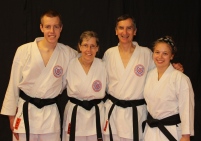
Black Belt Family
Welcome to our conversation on karate. Please join in!

Black Belt Family

Do you begin with the end in mind? Do you know what success looks like prior to beginning a new technique or kata? The teacher begins with a picture of success looks like. They have already seen a technique or kata performed and have performed it themselves. The student hears the picture and may even see their sensei or another higher ranking student perform the technique or kata and it looks wonderful. Then, we get our first shot at the new technique or kata and it looks nothing like the picture originally presented or shared with an example. What happened?
We need to know where we are going—the big picture—in order to know if we have arrived. However, when I am leaning a new technique or kata, I just need the first and sometimes second move. I have been working on a weapons kata using Kama. The first time I saw it performed, years ago in a competition; I was amazed by this kata. To perform the kata, you hold a weapon in each hand with a sharp blade and perform cutting motions. It looked like fun to perform and I am sure that when I learn this kata it will be. At this point, I know the shape of the kata and have a fuzzy picture of what it will look like. My finished picture looks nothing like my teacher’s picture or even the one I recollect from the tournaments and from my classmates who know the kata.

kata on the beach
We do not have a communication problem. My image of the kata in my head does not resemble my ability to execute the kata as it is not in focus. Looking at my kata and my mental picture:
Take a moment with me on this. Are you focused on the details here?
I have sometimes thought to myself, I should be able to pick up this skill quickly and then have a good reason why. Of course my baseline motive is to look good in class, impressing my sensei and my fellow students. When we are too obsessed with looking good in class, we fail to pick up on the subtle details in the teaching because we stopped being open to learning. It’s being open to learning the little details that will make all the difference when performing that new kata later on, after the class. I generally need to take a step back and observe what’s happening and need to re-draw my mental picture and compare it to the big picture being shared. Once I do, I will try to fit what I know into what I believe is the big picture.
After I write down what I think I know of the sequence of a kata and practice it at home, I begin to see the whole picture. If you are like me, you will also see where your knowledge is incomplete. If you skip the step of writing down after class you will have a much harder time when you are practicing at home. Without writing down after you initially learn something new, you are denying yourself the opportunity to grow and merge your picture with that of your teacher.
Once I have practiced at home and come back to the dojo, I am ready for instruction on the complete picture. Our sensei tells the story of his teacher who would share the first few moves of a kata and no more. The next week he would come back and declare he was ready for additional moves. The teacher would ask for a demonstration of what he had learned and correct and always say, go back and learn these moves before you learn more. When the initial moves were mastered, more were added. This technique helps cement the basics of the kata, and they are then internalized.
How about you, are you seeing the big picture of the skill you are looking to learn? Does your picture match that of your teacher? Take a look at your notes; do you have the details in them that are needed to answer your questions without assistance from someone else? When we sow small seeds in our kata garden, we sow them meaningfully and we gain a large harvest. When we are hasty and try to skip out on the details, our picture is incomplete and we fail to master the kata and move forward in our goals.
See you in the dojo soon!

Are you pushing yourself hard enough? Have you been practicing the 12 days of karate? One of the benefits of attending our dojo and most dojos I know about is we teach discipline and respect. Now that you have worked on the challenge and are back at the dojo, do you have a hard thing rule? In the book Grit: The Power of Passion and Perseverance by Angela Duckworth, she describes her hard thing rule (page 241):

A family working on the hard things
We worked with our kids; we ensured that all of them had at least one after school activity in high school each semester. It could have been track, band, or debate or any other after school club. We followed a rule similar to the one outlined in Grit In our case, the activity (hard thing) became karate because our kids chose karate. When they were younger, yes, we signed them up for certain sporting activities and allowed then to quit after the season was over if that is what they wanted. They always had to finish the season or the commitment. As an adult, we find that we still pay attention to this hard thing rule. Is this something you can add to your goals?
Discipline and high expectations is what we expect for every class. It begins when we arrive at class early and bow when entering the dojo. It continues with bowing to the sensei at the beginning of class and standing in line, no wiggling allowed, by age and belt. We notice when techniques are improperly executed and repeat drills to ensure they are learned properly. Our sensei demands a response from his teaching, and when we give that response we feel part of this select community.
It is easy to just let a class lapse into having fun without a path to follow. Of course, no instructor would want that for their students and no student, after experiencing that environment, would go willingly back to that environment. Think back to your favorite teacher. Mine was my high school physics teacher, and no, I did not study physics in college. He was demanding and expected us to push ourselves. Looking back, he expected more of us than almost any other teacher in the school. The work was not impossible.
To progress and grow we need to resist that easy path, the one without discipline and high expectations. Yes, it is more work. If we take the path of most resistance, we will push ourselves out of mediocrity. When we push ourselves out of mediocrity, we find ourselves in the area where we are challenging ourselves to be the best we can be. We want to achieve excellence. When we speak about the black belt test at our dojo, we often speak about endurance. We train for the test because we know that it will be a long test. The elements of the test are known and should be part of our regular practice. It takes a while to build up endurance. It turns out that endurance, or perseverance, is about 90% of the martial arts. Will power (determination or grit) is required to accomplish what is considered impossible by a white belt or other students in karate.
When we are on the path of most resistance, we want to compare ourselves to the people around us. This is an application of the hard thing rule in action. You may be tempted to say “Compared with the rest of my belt peers, I’m doing great.” Of course you can always say, “(name of your hero) has the same 24 hours that you do.” The only comparison we should do is with ourselves and not with others. Take a look at what would happen if, for example, if you compared yourself and your skills to your hero, how well would you compare? No matter who they are, they have the same 24 hours that you do. The change that is required is with the person we see in the mirror, me included. I need to step up and slowly practice that new kata and work out my mistakes.
The person who has “made it” to black belt put in the time and the hard work. They showed respect for the dojo and their sensei. When our sensei goes to teach class, he does not compare himself with other senseis or dojos. He is looking at what the best experience should be and is constantly and consistently improving those things for us. Do you have high expectations of yourself and what you are doing in your karate practice? Does your teacher have high expectations for you and the rest of the class? Are you doing work in your practice that challenges you? The foundation of this teaching is the high expectations and relentless focus on the best teaching for martial arts he can find or invent. Go and sign up for your own hard thing rule.
See you in the dojo soon!

If we take the path of most resistance, we will push ourselves out of mediocrity.

Have you been practicing in December like you were the last 11 months? We have not been practicing as much this month either. To get us back on track, Sensei Mae and I came up with the 12 day Challenge. We are going to make a game, based on a familiar Christmas song, of this challenge. It is Christmastime here and we are going to play some board games. I am sure when you and your family and friends get together you will play games as well. It may not be any of the titles we have on the table ready for the choosing here.

Let us know your favorite game
When we have class at the dojo we will often play games with the kids. I have found that the adults like the games as well. Games make learning fun and engaging. When I think about practicing and discipline, I think please pass the cookies and let’s play another game. When I think about playing a game, my face lights up and I become competitive, ready for the challenge—and now I am ready to do what it takes.
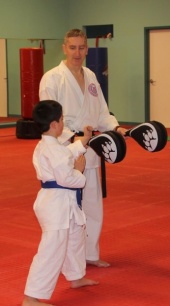
Playing games at the dojo
Consider joining Sensei Mae and me as we participate in the 12 karate days of Christmas. We are beginning the day after Christmas and will work into the first week of the New Year. Each day we have a challenge for you to open. Of course, just like the song, as each day goes on, you will need to repeat the prior day’s challenge as well as the current day. Are you ready?
The time we take to prepare for the coming season now will pay off as we begin to achieve our goals. Writing them down and reviewing them daily to see how we did and what we need to change will make a difference in the coming year when we reflect next year on this year’s accomplishments.
Join us as we play games and then join our challenge. Day one is easy! All you have to do is show up and practice; I know it will be fun for you and me. Post your comments on how you are doing on the karate 12 day challenge.
See you in the dojo soon.


We all want the quick fix, the silver bullet, the one thing we can do to skip practice and still become the best. I loved that scene in Captain America where Steve Rogers is injected with the formula and grows several sizes in strength. Never mind that we have all learned we cannot have our cake and eat it too.
This week Sensei Mae shared with me a video on self-defense. We are not commenting on the quality of the technique. We have not tried the technique used in this video, and it is not part of our teaching. We are open to learning new things, however, we are not recommending anything other than our proven system.

At the dojo we practice modeling a technique.
We all know that the internet is full of videos like this one. The basic appeal is to get us to buy something. The marketing appeals to our instinct that if we watch the video, we will be safe. Just remember the technique and you will be able to overcome any obstacle. I do want to believe that I can have my cake and eat it too!
I am sorry to say that we cannot determine if a technique will work simply by watching a video on Facebook. As a kid, when I learned in biology class about osmosis, I set my biology book under my pillow in hopes of the material leaching through the pillow and into my brain for an effortless, unconscious assimilation of the knowledge from the book. All I received was a sore neck and no additional knowledge about biology. We will not have the time to search the web for the correct technique to learn when we require our self-defense skills, let alone be able to evaluate their validity.
At the dojo we teach self-defense, often from the very first class. This is one of the many reasons people take up karate. We do not think we will get into a lot of fights. Most of us believe we are possible victims requiring some self-defense training.
At the dojo we practice modeling a technique to our students and then letting them experiment with it. In a recent class, I taught several of our basic techniques. It was important that the students get hands on experience with it working and not working for them. We also ensure they take notes and practice the techniques. On the black belt test the candidates must show it working on black belt attackers. As an attacker, the student only passed if they knew the technique. We would not fall for improper technique.
In class, we start with the most basic self-defense techniques to ensure all white belts have enough to save themselves from basic situations. We cannot cover every experience in class as time is always limited. We do know that we have a proven method for our teaching. As the students progress in training, we add techniques that people are less likely to encounter and are more difficult to learn. Of course, our best advice is always to avoid the situation and be aware of your surroundings. We only incorporate techniques that work all of the time. Even these techniques will only work if they are practiced and worked on by the students. It is great to have passed the black belt test. However, unless I am still practicing the techniques, I will not be able to call upon them when needed as my skills will have diminished.
We are working on teaching our students that to master the technique, they must train hard. This is similar to the work that psychologist Robert Eisenberger, at the University of Houston, is working on with his experiments. He has noted that when we learn to work for our reward, we perform better than those who do not have to work as hard for their reward (See his work [1992]. Learned industriousness. Psychological Review, 99, 248-267).
Dr. Eisenberger’s conclusion implies that we are more likely to learn new things when our initial learning experience was hard. Our push then for learning something new, like a cool new self-defense technique, is something we can struggle with and learn. My theory is that by struggling to learn a technique, we are more likely to recall and use the technique because we were forced to master that technique during training. So, just watching the technique will not help. Pairing up and working the technique is a great start to our journey toward mastery. Working hard for the goal is an effective way to learn. Maybe Sensei Mae and I will need to watch some videos and try them out.
We need to put in the hard work to achieve our goals and improve ourselves. What are you doing to ensure you are practicing hard (and not hardly practicing!) in order to achieve your goals? Keep in mind that you cannot learn self-defense from a video or a blog post. This is the time of year to review and reflect on what worked in the past and what should change in the future.
See you in the dojo soon.

The black belt test was a success last week and we had candidates pass the test. During the last part of the test, the fight, I was reminded of the Army Ranger, Green Beret core belief “improvise, adapt, and overcome.” The Army Rangers are a group that spends a lot of time drilling and preparing for situations. Hand in hand with the Green Beret belief is this quotation on planning: “Everyone has a plan until they get punched in the mouth.” This was said by Mike Tyson, a well-known champion boxer. This week we will look at how you can apply either the Green Beret belief or Mike Tyson’s in your next training, tournament or test.

Black belt’s who have Improvised, Adapted, and Overcome!
For my black belt test I prepared for the last part of the test as best I could. I survived the fights, which is about as well as we can expect when fighting two other black belts at the same time. Looking at the test from Saturday, and hearing Sensei Mae tell the candidates prior to and during the fights to use their training and demonstrated skills, I realize that all of the candidates, myself included, had the skills needed to do better than just survive. We were all highly trained; we just showed we knew more than 100 kicks, strikes and several blocks. We also showed we knew several katas that have direct applications to fighting. Prior to my test, one of the senseis had us practice fighting by using unique moves only from our katas. During the practice time we could not repeat moves until we drilled for one minute. That was a great drill; I recommend it when preparing for a test with fighting.
Here are some thoughts on how the Green Beret core belief improves our fighting:
Improvise: The dictionary has a few definitions for this verb:
Adapt. Here the dictionary defines this verb as: “to adjust oneself to different conditions, environment, etc.”

Black belt fight with Sensei Mae cheering on the brown belt candidate
Overcome: The dictionary defines this verb as: “to get the better of in a struggle or conflict; conquer; defeat.”
To obtain your top level goal, are you getting the better of the struggle against yourself? Are you ready to improvise—to adapt in order to overcome after the first punch in the mouth? How have you used this lesson in your life? What obstacle are you looking to overcome? See you in the dojo soon.
This guidance came out of a conversation on how the candidates for the black belt test today were preparing for their test. It started with one annoying thing that candidates do, and quickly grew. The sad thing is that most candidates don’t even realize that they’re engaging in these behaviors or that they are so damaging.
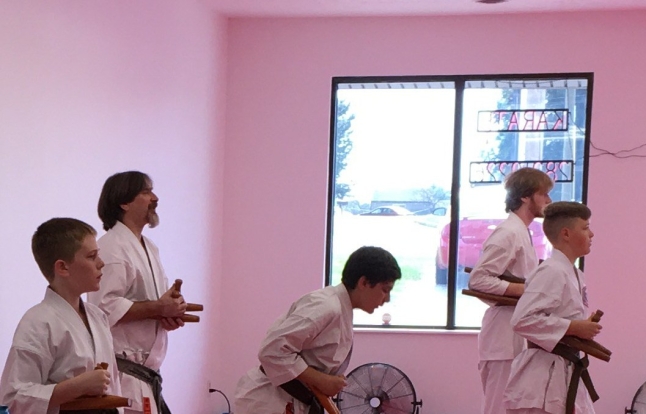
Are you ready for the test?
 Winning a medal is nice. Preparing for the test counts!
Winning a medal is nice. Preparing for the test counts!Approaching the test with fear or lack of confidence. We have seen the candidates who come to the test and go through the motions. Yes, the kata was nice. This is a battle for your belt. I was a little scared to take the test and fearful of my ability to perform for several hours. I trained hard and that training showed during the test. I had a fighting spirit that said to the panel judging me that I was more than ready to be one of them.

More board breaking
These irritations loom large for black belt candidates because we only have the test results to go on when deciding if you have what it takes to be on par with the other black belts. It’s easy to avoid them.
Be prepared in every sense and your test performance will be significantly better. See you in the dojo soon.
I trust that you are enjoying your martial arts journey. I have enjoyed writing this blog that started from a family conversation, okay several, about karate. We all just celebrated Thanksgiving and a few of us had karate conversations again around the table. I am thankful for readers of this blog. I am grateful to my teacher, Sensei Steve, for teaching us such excellent karate.
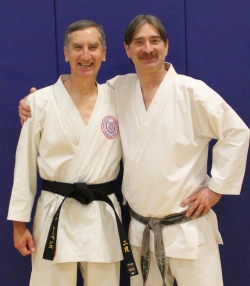
Sensei Glen and Sensei Steve
In thinking about our karate journey, our Sensei is a mentor to us giving us direction daily in class on how to handle ourselves in different situations. Our responsibility is the easiest, which is to show up for class. Okay, you might say, “I have done that this week.” I just worked with some of our black belt candidates on polishing their technique. They have been showing up for class for years and still had not worked on the small areas that make the techniques effective, such as how to grab or throw or even how to spin and kick.
I am reminded that we need to practice prior to class so we can polish what we learned in class. We worked through all of this with them and Sensei Mae is working with the same group and will likely have some comments as well.
The lessons we have learned as students of karate have had a profound impact on my life and that of my family. For a while I traveled internationally as a part of my job. I now know that going to another country is no more or less dangerous than going to the grocery store. The confidence that I received from my training in self-defense, being aware of situations and how to best win a fight (by avoiding it!) were ones that made the journey to another culture less daunting. In finding that new place to visit, I was drawn into the culture more quickly as karate has us in another culture already. A new culture was not as big of a deal as it would have been if we had not been studying karate and involving ourselves into karate as a new undertaking already.
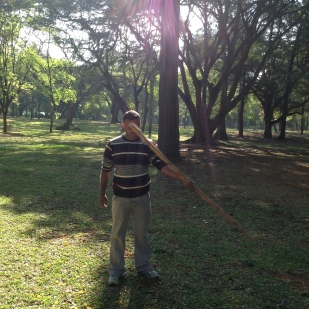
Daya working the bo staff in India
Was I concerned traveling? Of course I was. I have also been intimidated at local locations. It is no different the world over. One of my international trips brought me closer to my friends when I needed to practice with a bo staff. It is hard to explain a bo staff to someone without a context. I was so pleased when they arranged for one and that we found a place to practice. Practicing with a group of my friends in a park was also exciting as they wanted to see what all was done with this weapon and the others I had brought with me to practice.
I did not need to use any of my karate skills while traveling internationally. I was confident and more aware of what I was doing and where I was going. I thought about how I would handle a group of people or avoid them when I saw them coming. I tried to travel in a group, when possible, so I was less of a target.

Sensei Glen bo staff in India
All of this thinking goes back to the basics of my martial arts training. I did not want to ever look like a victim walking on the streets. When we traveled to San Francisco this summer and took the public transportation, we applied the same lessons and enjoyed the challenge of keeping safe.
I have a lot to be thankful for in my karate journey. As we approach the end of the year, are you looking at what you can accomplish? Do you have a plan?
Happy Thanksgiving! See you in the dojo soon.

Do you have what it takes? I read a story recently about Muggsy Bogues, the shortest man, at 5 feet 3 inches, to play basketball in the NBA, where he played for 14 years. This is a league where the average player is 6 feet 7 inches tall. How do you overcome that disadvantage? A high achiever chooses to do uncommon things. They actually practice and work on overcoming obstacles to winning.

Are you ready to climb the ladder of success?
When our sensei asks black belt candidates how long they are practicing for the black belt test on a daily basis, we could predict the success or failure rate from the student responses. The successful candidates put the time in each day to make a difference in their karate career. One of the reasons they practiced daily was their strong desire to succeed and pass the test.
When it was time for my test, I was not satisfied with remaining a brown belt, especially when my daughter, Sensei Mae, was already a black belt. I had a fire within me to work hard and not miss the opportunity to succeed on the test. In addition, I was much older than many of my classmates and I did not have the luxury of failing and becoming a long-term brown belt. No, I wanted to pass this test and the next. My desire was high; I found opportunities in my day that I had not ever considered. I made some sacrifices to concentrate on this one goal. I wanted to reach my black belt potential and fulfill my dream of becoming a black belt.
The effectiveness of your desire and training plan will determine your likely chance of doing well at a tournament or passing your belt test. What matters is how strongly your reasons are for achieving a goal. That is what will drive you to complete that goal. To determine if you have what it takes, find your desire level on the chart. If you have a high desire you are much more likely to meet the goal.

Last week was the Commonwealth of Kentucky AAU karate tournament, held at our dojo. The tournament was a big success for those who participated in the event. People that have reached the gold medal in this tournament did not get there by chance. They did not put “common” or “going through the motion” effort into their achievements. These athletes did uncommon things that you may not see. They practiced and worked in a way that their competitors did not. They put in the effort to make themselves distinguished. And they had a high desire to succeed.
Muggsy Bogues had a high desire to succeed, despite his height disadvantage. He loved to play basketball and learned early on that he had to disrupt the play of taller players and make them not even want to dribble the ball near him. He practiced a lot and worked on his game daily. How is your desire to succeed? Are you focused in on the goals that will achieve success for you today and in the future?
See you at the dojo soon.
The secret to move from up from white belt is to show up at class consistently. The next thing you will want to know is how do I obtain my black belt? Of course for that you need a plan, a good teacher and commitment to a goal. Each dojo is different and has different colors for their belts. As you advance to the (generally) higher and darker colored belts, the plan is what we can help with the most on Let’s Talk Karate.

Let’s go over that plan
My friend has come for a few weeks as a new karate student and is really enjoying his white belt experience. It has been good for him to get out and take out some frustrations that are best not left in the house. As a white belt, all the training he is receiving is fundamental knowledge. It has been good for me to see again what it means to be a brand new student of karate. Our sensei has a plan for all students, the number of expected weeks between belts, the skills, weapons and kata required. Besides regularly attending classes, the element that got our family to move up from white belt was a plan. Do you have a plan for the coming year on your next steps for your training plan? Now is time to think about next year.
One of your first actions should be the development of a training plan. A well-developed plan will encourage you to keep showing up and suiting up to progress. It will also clarify the goals you have for the training program. Here are the five common mistakes to avoid in developing your karate plan of action for next year:
If you would like assistance in working on your training plans for the coming year, please let us know. We are working on our goals for the coming year as well. Our local tournament is this weekend. Try to find one to challenge yourself and see how well your training is going. See you in the dojo soon.
To progress, most of what you need is to suit up and show up to the dojo on a consistent basis. If you fail to suit up and show up, your skills become stagnant and you are no longer growing on your karate journey.
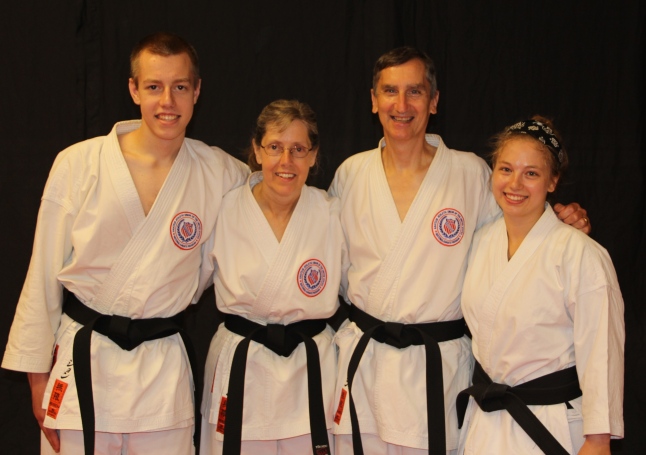
Suit up, show-up consistently!
When we signed up for karate, we looked for three things, probably the same as you:
As good shoppers, we had the kids attend a week long karate camp in the summer. We were interested in ensuring they could learn and wanted to attend. We also discussed with some of our friends where they sent their kids.
We have stayed suited up and showing up for three main reasons:
All of this is to say that if you find yourself in a dojo and you are not consistently learning and growing as well as advancing, you may want to look around for a different instructor in martial arts. My guess is this is a rare occurrence when we are in our first few years of training.
The point about testing our skills is to do so in structured ways, not going out to fight random strangers on the street. Our recommendation is to go to clinics and tournaments. At clinics and tournaments you will be able to see your training in action against students outside of your dojo. In a clinic, you will learn from other masters. I would not say that losing a fight is due to poor teaching. I have lost fights and know I have a very good sensei. It is looking at the whole work being performed at the dojo.
As a white belt, my son encountered some different fighting skills and lost a few rounds early in a tournament. Was our teaching bad? No it was not. We did not know how much work or effort was needed to become a champion at our first competition. We had never been tested outside of our classmates. So, the next time we encountered students from the same school we did better and won more rounds as we worked on new skills. On the whole, our dojo students win more than they lose. Of course we have never been 100% in the win column. I lost the gold medal fight in the AAU national tournament. It was my lack of skill and not the coaching from our sensei. It was a close fight, and a loss. I was able to learn from that experience to become a better fighter.
Your preparation does indeed determine what you will achieve from any program, and karate is no exception. You will continue to learn and grow as long as you continue to suit up and show up at the dojo door. See you in the dojo soon.